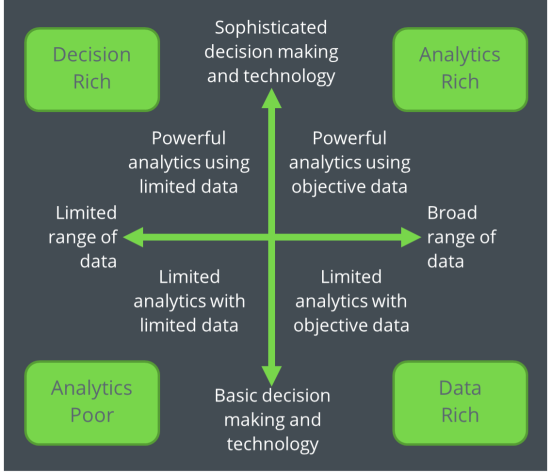Talent Data at the New Frontier
Despite talent data being vital to talent decisions, there is a mixed bag of objectivity and analytics capabilities across organizations.
Share
Why talent data matters
We know that data is core to talent decisions. Evanta, in their 2022 research, found that data and analytics are the number one trend for CHRO investment in 2022. Furthermore, Mercer’s 2022 Global Talent Trends report highlighted improved workforce planning as the number one human resources priority. This planning, though, needs to be grounded in objective data. However, organizations vary dramatically in relation to their talent data and the capabilities in relation to associated analytics and decision making.
A varying landscape
Despite the criticality of data and the role that it is increasingly playing in talent decisions, organizations vary in relation to two dimensions: the range of data on the one axis, and decision-making capability with associated technology on the other. In relation to the first, it is not that organizations do not have talent data but rather whether the data they have is considered objective and can be used with confidence. Equally, organizations also vary in their collection and use of data relating to competencies, behaviors, and skills. On the other hand, on the analytics capability and technology dimensions, organizations vary from descriptive reporting (turnover percentage, as an example) to more sophisticated predictive modeling. Equally, technology also varies in its complexity and usability.

What do these two dimensions mean for organizations then? To begin, they provide some guidance on maximizing the value of decision-making within their quadrant, while understanding the actions need to move to a different quadrant. While it is tempting to assume that all organizations should be in the Analytics Rich quadrant, an important starting point is identifying and understanding the quadrant you are currently in, and where you would like to be. Not every organization needs to be at the very top of the Analytics Rich quadrant. Let’s consider some actions that organizations can take in relation to each quadrant.
- Analytics Poor: As an immediate start, organizations in this quadrant can begin to implement different assessments to increase both the objectivity and range of talent data. These could include personality and behavioral assessments, motivation assessments, or skills and ability tests. This objectivity begins to remove the subjectivity of talent decisions. Tools such as talent dashboards provide a consistent manner in which to view and report on talent data. Supporting decision-makers with analytics coaching and training may be beneficial.
- Data Rich: While organizations in this quadrant have access to a broad range of talent data and data that is more objective, they typically lack either the analytics capabilities or more sophisticated tools to make sense of—and use—the data in talent decisions. Developing and supporting analytical skills is critical, as is the implementation of an insight platform that provides access to the data, and insights that are quick to generate and analyze in relation to your business challenges.
- Decision Rich: Access to the most sophisticated technology, and available analytical skills, provide little benefit if the talent data being used is inconsistent, varied, and/or subjective. Organizations in this quadrant have the former but need to develop the latter. Immediate action may be the cleaning and standardization of available data, together with the implementation of data collection tools—such as psychometric assessments—that provide objective and consistent talent data.
- Analytics Rich: Organizations are rich in relation to both their access to talent data and analytical capabilities, as well as the use of technology. However, it remains critical to determining whether the data available supports the talent decisions needed, and which data provides the greatest predictive value. Data grounded in science is crucial. Similarly, the technology used should provide quick and focused access to data to support decision-making at all levels within an organization. Similarly, analytics skills should be enhanced and supported at all levels.
While it is tempting to assume that all organizations should be in the Analytics Rich quadrant, an important starting point is identifying and understanding the quadrant you are currently in, and where you would like to be.
Objective talent data for better decision-making processes
Successful talent data analytics and decision-making is a combination of the quality and consistency of the data together with effective tools that support talent decisions. Four capabilities, at the heart of SHL, support action in any of these quadrants or in moving from one to another.
- Products – Your data, particularly in relation to talent data and psychometric assessments, should be objective, valid and reliable. Data and assessments rooted in science are a prerequisite for driving analytics and decision confidence.
- Experience – Providing a positive experience for your decision-makers enhances the sense of confidence in relation to talent decisions. Access to objective, real-time talent data is a minimal starting point in the decision-making process.
- Services – Provide high-quality, high-touch support for data analytics and decision-making. While training in talent analytics is beneficial, coaching and mentoring in data analytics to support decision-making is key. Coaching and mentoring that focuses on available data, on critically evaluating that data, and interrogating data in relation to the organization's objectives, is critical in ensuring that talent decisions meet organization objectives.
- Insights – Talent decisions are often the balance between the speed with quality of talent data. Leveraging technology here is key. Technology, such as the SHL Platform, provides access to always-on data, within insights that are quick to produce, and intuitive to analyze. Critically, the data you collect should have application across talent decisions, thereby increasing utility and value. Technology should also allow for access at different levels, supporting decisions from the aggregate to the individual, from the executive to new starters. Data, and your technology, allow for talent management to be democratized and positively impact all employees within your organization.
Successful talent decisions are the intersection of the quality and accessibility of your talent data, together with analytical skills enabled and supported by technology. Understanding where you are in relation to the talent analytics landscape allows you to take focused actions to improve your talent decisions, whether starting a journey towards being analytics rich, or enhancing your available data and technology to further improve your talent decisions. Mapping your talent analytics landscape allows you to maximize the value of your talent data, support data-driven talent decisions, and push your talent frontier!
Register for our webinar to learn how you can make better, more accurate, and objective talent management decisions!









